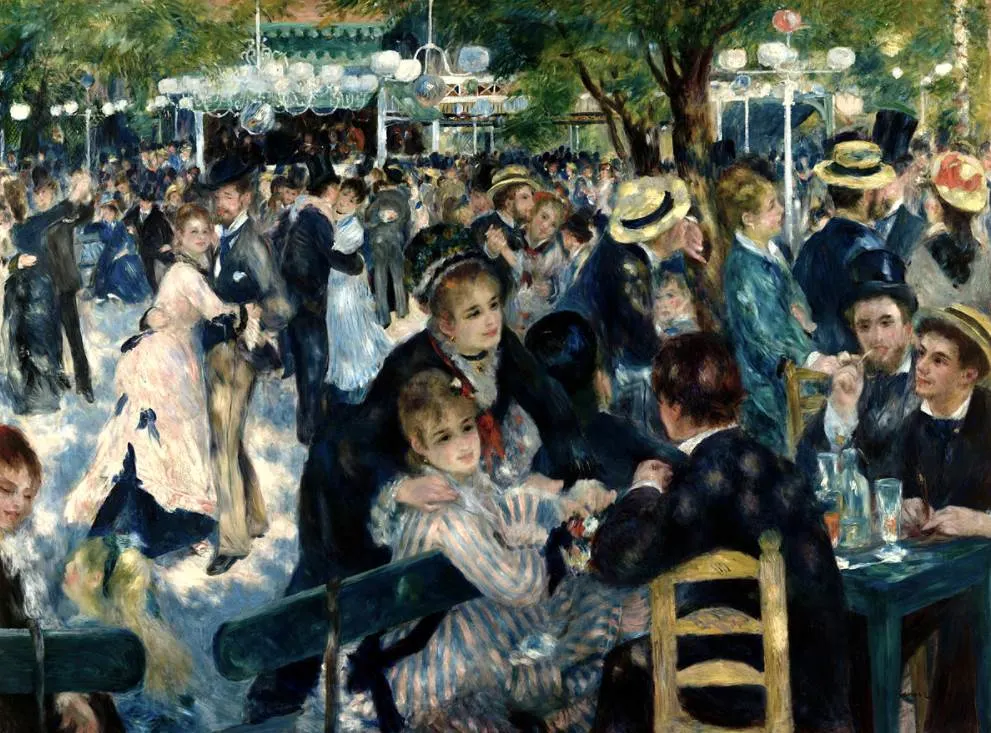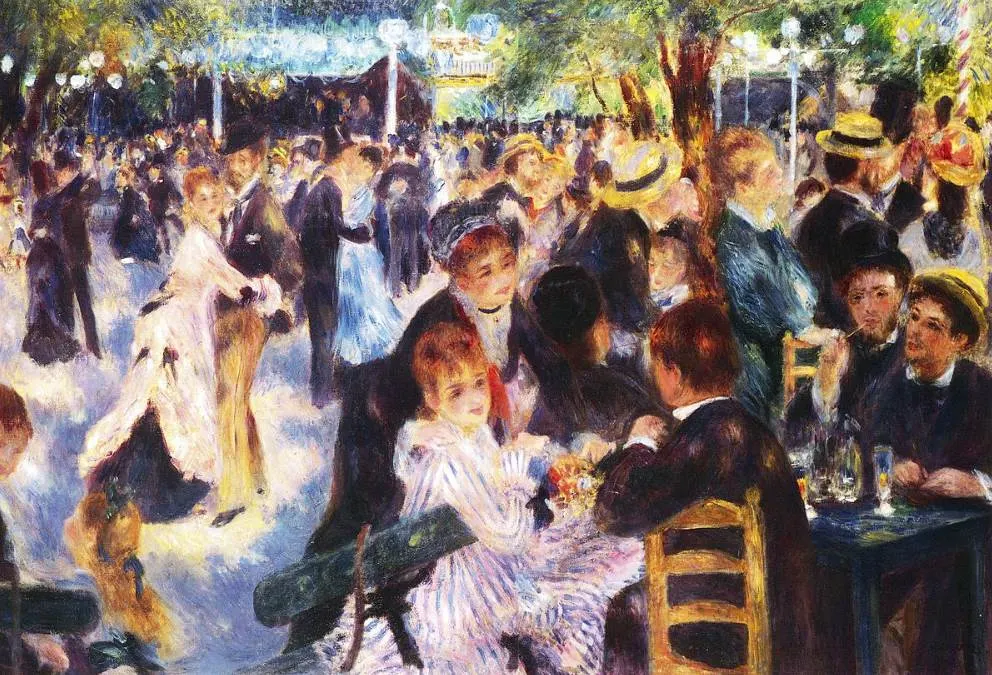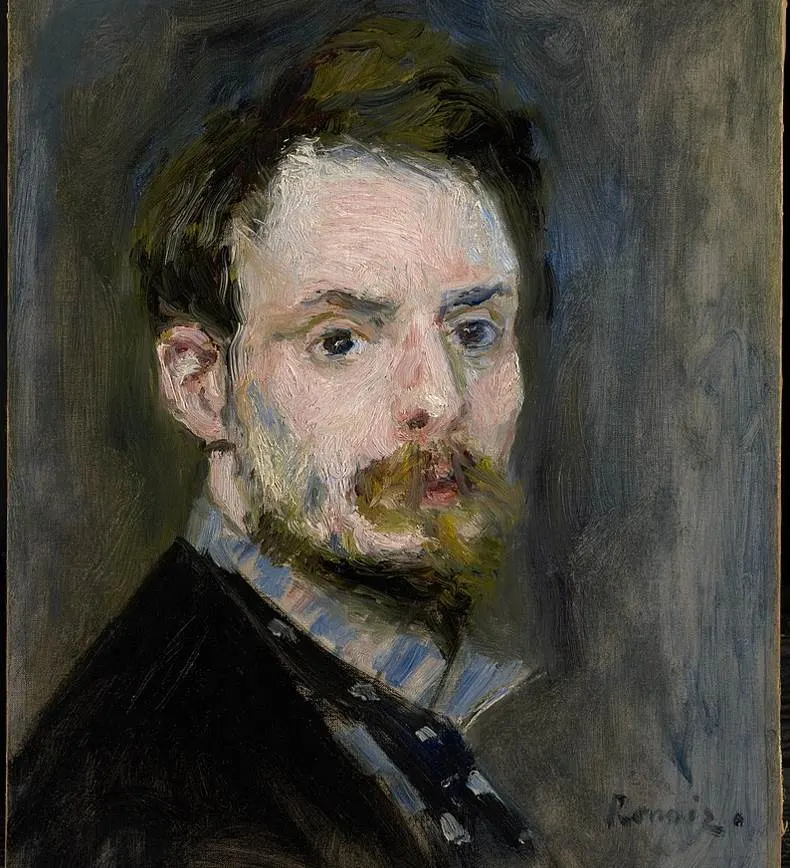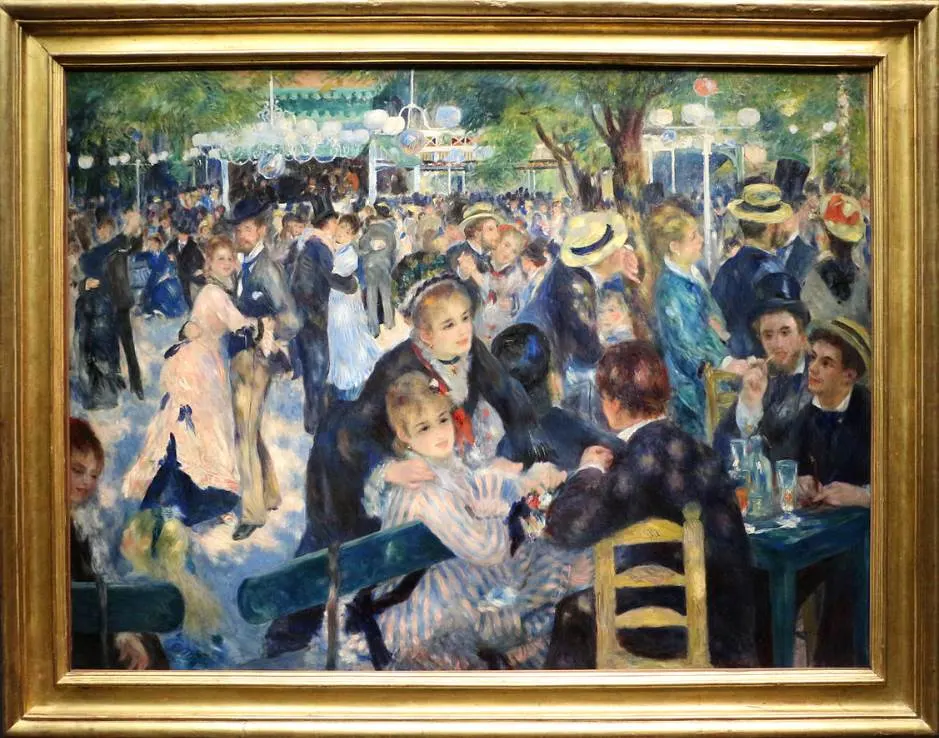This painting has been described as the epitome of Impressionism, an art movement that emerged in the late 19th century and which had a profound effect on modern art.
Clear brushstrokes and a sense of motion make the scene appear to come to life where some of the ideals of the Impressionist artists, and these elements shine through in this remarkable work of art.
Let’s take a closer look at some of the most interesting facts about Dance at Le moulin de la Galette by Pierre-Auguste Renoir, one of the artist’s ultimate masterpieces.
1. There are two versions of the painting completed in the 1870s
Dance at Le moulin de la Galette is also known as “Bal du moulin de la Galette.” It’s the name of two paintings by Pierre-Auguste Renoir (1841-1919) that he produced in 1876.
It’s unclear which version he painted “en plain air” on the spot, a characteristic of the Impressionist artists who were gaining popularity during this period in history.
The two paintings differ significantly in size as well and feature different color schemes. Apart from these differences, they are virtually identical.
Version 1 – 131 × 175 centimeters (52 × 69 inches)

Version 2 – 78 x 114 centimeters (30.7 x 44.8 inches)

2. It depicts a weekly event in the Montmartre district of Paris
The Moulin de la Galette is the name of originally two windmills that are located in the Montmartre district of Paris. This district is known as the artistic quarter as many famous artists have lived here.
Today, you can still have your portrait drawn at the Place du Tertre as many artists offer their services here.
The mill was originally referred to as “Blute-fin,” a reference to its purpose of sifting flour. It was turned into a “guinguette,” an establishment where Parisians could drink and eat, in the early 19th century.

The current name of Moulin de la Galette is a reference to the crusty cake that Parisians ate here. The painting depicts a typical Sunday afternoon at this crowded establishment.

3. The artist’s studio was transformed into a museum in the 1960s
Pierre-Auguste Renoir was one of the leading figures of the Impressionist art movement along with Claude Monet (1840-1926). This means that he often hung out in the Montmartre district along with his colleagues.
He got the idea to paint Dance at Le moulin de la Galette after visiting the establishment in May of the year 1876.
To make it easier to paint this magnificent work of art, he rented a studio and settled here. His studio was just walking distance east of the mill in the Rue Cortot.
Other famous places in the area are the Place du Tertre, the famous square where artists still work today, the Sacré-Coeur, the amazing church in Paris on top of Montmartre Hill, and the Montmartre vineyard.
The studio where Renoir lived was transformed into the Montmartre Museum in 1960. The buildings and garden are over 3 centuries old and many artists lived here.

4. Renoir’s main choice of model refused to pose and was replaced by her sister
The most prominent figure in the painting is the young girl in the foreground. She somewhat looks toward the viewer as most other people are preoccupied with having a good time.
Her name was Estelle Samary, the sister of one of Renoir’s most favorite models, Jeanne Samary. Both girls visited this establishment with their families every Sunday afternoon.
What’s remarkable is that Jeanne refused to pose for this painting because she was allegedly having an affair with a local boy at the time, so her sister posed instead.
Her mother stands right behind her and the men sitting at the bale next to them have been identified as Pierre-Franc Lamy and Norbert Goeneutte. The latter was a friend of Renoir and a famous French artist as well.

5. There’s a sad backstory about one of the dancing models
Renoir included multiple of his friends, many of who were artists as well, in the painting. Some of these are Henri Gervex, Eugène Pierre Lestringuez, and Paul Lhote.
In the left-center of the painting, you can see a Cuban artist named Don Pedro Vidal de Solares y Cardenas. He appears to be uncomfortable because he was dancing with a rather wild girl named Marguerite Legrand, referred to as “Margot” at the time.
The girl was trying to make him loosen up a little without a lot of success, something emphasized by the way he was portrayed by the artist.
Margot was another model of Renoir and she became gravely ill two years after Dance at Le moulin de la Galette was completed. She died of typhoid shortly after and Renoir was with her on her deathbed and paid for her funeral as well.

6. Painting Dance at Le moulin de la Galette was quite complicated
Despite renting a studio, especially to paint this iconic painting, Renoir had a hard time completing it.
The Montmartre district is located on a hill and the place can get quite windy. He was forced to constantly hold the canvas on several occasions to avoid it would blow away in the wind.
Some art historians have suggested that it was the smaller version that was completed en Plein air and the larger one that was completed in his studio. After all, the smaller canvas would have been much easier to control.
Whether or not this is true remains uncertain, although it appears that the smaller version was painted more spontaneously, a typical characteristic of outdoor paintings.

7. The smaller version was sold for a record amount in the early 1990s
One of the two versions was exhibited at the 3rd exhibition of Impressionists in 1877. One of the most remarkable facts about Dance at Le moulin de la Galette is that we don’t even know which version was on display during this event.
The smallest painting was owned by John Hay Whitney (1904-1984), the former president of the Museum of Modern Art in New York City, and his widow auctioned it in 1990.
It was sold on May 17 of that year for US$78 million at Sotheby’s in New York to a Japanese businessman named Ryoei Saito. 2 days earlier, the Portrait of Dr. Gachet by Vincent van Gogh was sold for US$82.5 million to the same man, a record at the time.
8. Where are the paintings located today?
The alarm bells of the world of art went off when the eccentric Japanese businessman announced that he would have both paintings cremated along with him after he passed away.
This never happened because his company went bankrupt and both paintings were seized. The exact whereabouts of The Portrait of Dr. Gachet and the smallest version of Dance at Le moulin de la Galette remain unknown until today.
The biggest version of the painting was owned by the French painter Gustave Caillebotte (1848-1894) between 1879 and 1894 and became the property of the French Republic after his death.
It hung at the Musée du Luxembourg between 1896 and 1929, at the Musée du Louvre between 1929 and 198, and is currently on display at the Musée d’Orsay in Paris.

